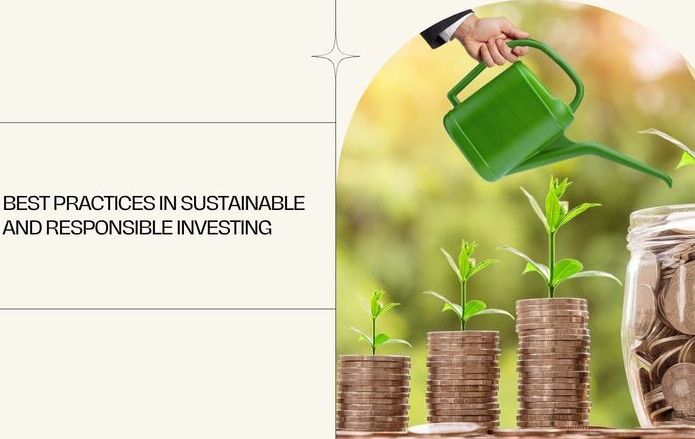Best Practices in Sustainable and Responsible Investing

Sustainable and responsible investing is gaining attention in the financial world. Investors are increasingly focusing on the long-term impact of their investments.
Understanding Sustainable and Responsible Investing
Sustainable and Responsible Investing (SRI) involves strategies that consider environmental, social, and governance (ESG) factors in investment decisions. SRI looks beyond traditional financial analysis to include a broader perspective of corporate responsibility and societal impact. This approach reflects a growing awareness among investors about the influence their investments have on the world.
Best Practices in Sustainable and Responsible Investing
1. Comprehensive ESG Criteria Evaluation
Effective SRI necessitates a thorough assessment of a company’s ESG criteria. This includes analyzing a company’s environmental policies, social practices such as labor rights and community engagement, and governance structures like board diversity and transparency.
2. Active Ownership and Shareholder Engagement
Active ownership means investors not only choose companies that align with SRI principles but also engage with these companies to promote better practices. This can involve voting on shareholder resolutions or directly communicating with company management.
3. Integration of SRI Across Asset Classes
SRI is not limited to stocks. It can be applied across various asset classes, including bonds and alternative investments. For instance, green bonds are issued to fund projects with positive environmental benefits.
4. Continuous Performance Monitoring
Regular monitoring of investment performance against ESG criteria is essential. This helps ensure that the investments continue to align with the investor’s SRI goals.
Trends and Innovations in SRI
1. Rise of Impact Investing
Impact investing focuses on generating specific, positive social or environmental effects, in addition to financial returns. This goes beyond avoiding harm and actively seeks to make a positive impact.
2. Technological Advancements in ESG Data Analysis
Advances in technology, such as AI and big data analytics, have improved the ability to analyze complex ESG data. This helps investors make more informed decisions based on a comprehensive set of ESG factors.
3. Expansion of SRI Options
The range of SRI options has expanded, with more mutual funds, exchange-traded funds (ETFs), and other financial products focusing on ESG criteria. This makes SRI accessible to a broader range of investors.
4. Regulatory Developments
There is an increasing focus on ESG disclosures and regulations. This includes developments like the EU’s Sustainable Finance Disclosure Regulation (SFDR), which aims to improve transparency in how sustainability risks are integrated into investment decisions.
Sustainable and Responsible Investing in Practice
1. Case Studies of Successful SRI
Examining successful SRI examples can provide valuable insights. Companies that have effectively integrated ESG practices often demonstrate improved long-term performance and resilience.
2. Challenges and Solutions in SRI Implementation
Implementing SRI strategies can present challenges, such as limited access to reliable ESG data or difficulty in quantifying the impact of investments. Solutions include leveraging technology for better data analysis and collaborating with experts in the field.
Investing in a Sustainable Future
As part of the growing interest in SRI, platforms like Coinvesting offer avenues for investors to engage in responsible investing. Such platforms provide resources and tools that facilitate informed investment decisions aligned with individual values and societal impacts.
Future Directions in Sustainable and Responsible Investing
1. Advancing ESG Integration Techniques
The future of SRI involves refining ESG integration techniques. This includes developing more sophisticated methods for assessing and quantifying ESG impacts in investment portfolios.
2. Collaboration for Greater Impact
Collaboration among investors, companies, and regulatory bodies can enhance the effectiveness of SRI. This includes joint initiatives and partnerships that aim to standardize ESG reporting and promote best practices.
3. Education and Awareness
Increasing education and awareness about SRI is crucial. As more investors understand the benefits and methodologies of SRI, there is likely to be a broader adoption of these practices.
4. Innovation in Financial Products
Innovation will continue to play a key role in the development of new SRI financial products. This could involve novel investment funds, ESG-focused fintech solutions, and other creative financial instruments.
Conclusion
Sustainable and Responsible Investing is not static. It evolves with societal changes, technological advancements, and regulatory developments. The future of SRI holds promise for a more sustainable and equitable financial market, where investments align with broader societal goals. By staying informed and adaptable, investors can navigate this evolving landscape, contributing to a more responsible and impactful investment ethos.

Pranab Bhandari is an Editor of the Financial Blog “Financebuzz”. Apart from writing informative financial articles for his blog, he is a regular contributor to many national and international publications namely Tweak Your Biz, Growth Rocks ETC.








